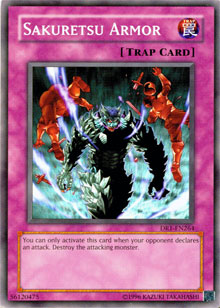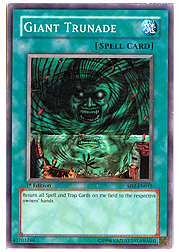Monster removal is everywhere. You can’t look at a Shonen Jump Top 8 decklist without seeing a vast combination of Sakuretsu Armors, Smashing Grounds, Mirror Forces, and other cards that involve getting opposing monsters out of the way. But despite what many players believe, monster removal cards can be quite difficult to play. In today‘s article, I will outline what I think is the appropriate strategy to use in monster removal.
Begone, Knave?
 There are a few different types of monster removal card available to us under the current Forbidden and Limited lists. The first group includes direct removal cards, such as Smashing Ground and Sakuretsu Armor. These are simple “Destroy 1 monster” cards that are usually 1-for-1 trades. The second group includes “bounce” removal cards, which return a card to the opponent’s hand. Examples include Compulsory Evacuation Device and Ordeal of a Traveler: cards that temporarily solve a bad situation by getting a monster out of your way for the turn. Then there are the indirect removal cards, such as Enemy Controller and Waboku, whose effects aren’t directly linked to monster removal but can still do it when combined with monsters of your own.
There are a few different types of monster removal card available to us under the current Forbidden and Limited lists. The first group includes direct removal cards, such as Smashing Ground and Sakuretsu Armor. These are simple “Destroy 1 monster” cards that are usually 1-for-1 trades. The second group includes “bounce” removal cards, which return a card to the opponent’s hand. Examples include Compulsory Evacuation Device and Ordeal of a Traveler: cards that temporarily solve a bad situation by getting a monster out of your way for the turn. Then there are the indirect removal cards, such as Enemy Controller and Waboku, whose effects aren’t directly linked to monster removal but can still do it when combined with monsters of your own.
Direct removal cards are quite easy to understand. The widely accepted truth is that one should use them to help push tempo, as well as removing a threat one could not otherwise take down in battle. Generally, smart players almost never use a direct removal card on a monster that has already paid for itself.* These guidelines work well for most decks in the current metagame, which try to out-resource opponents before pounding away at life points. Other decks, such as the Bazoo the Soul-Eater/Return from the Different Dimension combo decks, want to use direct removal to help push tempo their way and end the game fast.
Personally, I recommend using monster removal only to destroy something that you can’t take down in battle. If you’re able to destroy a monster in the battle phase, it is almost always better to do so and save your removal card for something you can’t take out. If you waste your monster removal cards too early, you’ll find yourself staring down an indestructible Jinzo that you could have otherwise dealt with easily. However, every rule of strategy has exceptions. For example, if the only two cards you have are Tsukuyomi and Smashing Ground, your life points are at 100, and your opponent has nothing but Zaborg the Thunder Monarch face-up on the field and Treeborn Frog in the graveyard, it would be wise to use Smashing Ground on Zaborg and set your Tsukuyomi. Low life points are usually the turning point for strategy, when a player is desperate enough to take losses in advantage just to stay alive.
Bounce removal effects are significantly weaker than direct removal. It’s always better to negate the attack and destroy the monsters rather than just delaying the monster’s attack. However, bounce removal can still be playable when the situation is right. Cards like Ordeal of a Traveler and Begone, Knave! are continuous traps, and as such, allow you to bounce multiple monsters with their effects. They have some drawbacks that prevent them from being widely played, but I can attest to the fact that playing around Ordeal of a Traveler can be quite difficult.
 Bounce cards also let one player expand on the effects of a restricted card. Two Forbidden lists ago, Rhymus Lizo was infamous for playing a single Giant Trunade in every deck he ran. Trunade was widely considered an inferior card. But while Heavy Storm was obviously better all-around, the Trunade often acted like a second copy of Heavy Storm. Kris Perovic (a teammate of Rhymus) once told me that Lizo could talk forever about why Giant Trunade was actually better than Heavy Storm. It got me to thinking, and I realized that, as a –1 card, players would be unlikely to chain their Scapegoat to it, and instead pick up the +1 advantage Giant Trunade offers. This could let Rhymus explode with his Cannon Soldier and massive field, using his opponent’s greed to ride all the way to victory.
Bounce cards also let one player expand on the effects of a restricted card. Two Forbidden lists ago, Rhymus Lizo was infamous for playing a single Giant Trunade in every deck he ran. Trunade was widely considered an inferior card. But while Heavy Storm was obviously better all-around, the Trunade often acted like a second copy of Heavy Storm. Kris Perovic (a teammate of Rhymus) once told me that Lizo could talk forever about why Giant Trunade was actually better than Heavy Storm. It got me to thinking, and I realized that, as a –1 card, players would be unlikely to chain their Scapegoat to it, and instead pick up the +1 advantage Giant Trunade offers. This could let Rhymus explode with his Cannon Soldier and massive field, using his opponent’s greed to ride all the way to victory.
In fact, I remember the first time I ever played against Rhymus. It was a side event, and I had no idea who he was. Since it was a rather casual game, I decided to see how smart he was. I set my Morphing Jar and five spells or traps, and declared that it was my “only move, and I just had to hope he didn’t have Heavy.” Rhymus proceeded to tell me he was in fact not stupid, hit my field with Giant Trunade, set all his spells and traps, and attacked into my Morphing Jar. Needless to say, the ridiculous advantage he generated led to a swift victory. It goes to show that there are always situations where so-called “bad” cards can work just as well as (or even better than) widely accepted staples. Don’t count out bounce removal cards until you’ve tried them.
The last category of monster removal is indirect removal, which are often defensive cards that prevent an attack and allow you to attack back. Well-informed players can take these cards and make them work wonders. While generally –1 trades, they can often make up for it with the field presence they provide. Take Magic Cylinder, for example. Using Magic Cylinder to protect Dekoichi the Battlechanted Locomotive from Kycoo the Ghost Destroyer is an excellent play, if you have Mobius the Frost Monarch in hand. It sets up a brutal follow-up turn, where the Cylinder allows you to destroy Kycoo. Though Sakuretsu Armor would have done the exact same thing (and is a much more stable card all-around) the Cylinder can act as a fourth Sakuretsu. Besides which, situations sometimes come up where Magic Cylinder can end games that Sakuretsu couldn’t.
The Lesson
It’s hard to pin down the exact way to use your monster removal cards. Generally, you shouldn’t use them if you can attack the monster next turn. However, life points decide a duel and not total card presence. Card presence is just a means to achieve an end. Don’t be afraid to break the generally accepted rules of strategy if it’s in your interest to do so. Play your game so that on the next turn, you don’t lose advantage or the rest of your life points. If you can do this, you’ll come out on top every time.
This concludes my Back to Basics series. Hopefully by now, you are a better Yu-Gi-Oh! TCG player and have a better understanding of why things work. Without understanding the mechanics behind your favorite cards, you’ll never be able to improve your game or properly handle new developments. I hope I’ve helped you with this, and that you’ve enjoyed this series. If you have any questions or comments, you can reach me at mpeddle80 at hotmail.com.
*“A monster that has paid for itself” basically means a card that has increased your card presence without taking any away. Flip effect monsters, such as Dekoichi the Battlechanted Locomotive, are a good example of this, since they instantly gain their owner a card. If Smashing Ground was used on Dekoichi, the Dekoichi player would lose one card (Dekoichi) but gain another card (the one that was drawn), while the opponent would lose Smashing Ground and gain nothing.